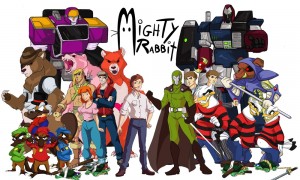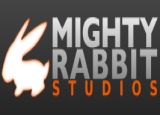 Mighty Rabbit Studios has a pretty big team as far as indie devs go, and it looks like your members brought a fair amount of game design experience to the table right off the bat. How did Mighty Rabbit’s founders happen to meet up after completing Terraform and Cylinder? Was it the Joystick Labs accelerator program that brought you all together, or had the team already congealed well before that point?
Mighty Rabbit Studios has a pretty big team as far as indie devs go, and it looks like your members brought a fair amount of game design experience to the table right off the bat. How did Mighty Rabbit’s founders happen to meet up after completing Terraform and Cylinder? Was it the Joystick Labs accelerator program that brought you all together, or had the team already congealed well before that point?
Nic and I had met back in 2005 while I was a student at Wake Technical Community College. We both worked on a really ambitious student project that never saw the light of day – it was terribly out of scope, the kind of thing only students would be naive enough to believe they could make in five months. After struggling on that project we maintained a friendship that lasted until I formed Mighty Rabbit proper in August of 2010. I didn’t originally have Nic in the cards for the studio because he was working at a very comfortable job – instead I opted to start Mighty Rabbit with two other people. It’s a long story, but neither of those two people worked out and I was left desperately in need of help. Nic came to the rescue by quitting his job and joining Mighty Rabbit full time.
 Our other talent came from a variety of places – mostly friends whom we’d met during our tenures in college. Adric Worley, our art lead, and Ben Moore, our marketing wizard, both met our team at the East Coast Game Conference in March of last year. They both joined shortly after that and we’re incredibly lucky to have them as they’re both insanely good at what they do.
Our other talent came from a variety of places – mostly friends whom we’d met during our tenures in college. Adric Worley, our art lead, and Ben Moore, our marketing wizard, both met our team at the East Coast Game Conference in March of last year. They both joined shortly after that and we’re incredibly lucky to have them as they’re both insanely good at what they do.
Cylinder was Nic’s first attempt at independent game production – it sold really well in Japan for some reason but never took off anywhere else. It’s a really fun and unique puzzle game that just never got a chance to stand out in the marketplace. It was the game that really sold me on Nic’s talents and made me want to be involved in creating a game with him. Our other past project, Terraform, was built by myself and one of our programmers, Kurt Hasian (as well as a few other talented NC State students), as our final student project in college. It didn’t play too much of a role in who joined the company, but it had a major impact on Joystick Labs’ decision to bring us into their program.
 I want to touch on Terraform a little more, because it’s incredibly interesting to see that it’s still alive not just as entertainment, but as a learning tool for chemistry students. Did you, Kurt and the rest of the team at NC State intend for Terraform to have a hard educational use, or did that come as a surprise? Are we anywhere near close to scratching the surface on the educational potential of videogames?
I want to touch on Terraform a little more, because it’s incredibly interesting to see that it’s still alive not just as entertainment, but as a learning tool for chemistry students. Did you, Kurt and the rest of the team at NC State intend for Terraform to have a hard educational use, or did that come as a surprise? Are we anywhere near close to scratching the surface on the educational potential of videogames?
Terraform was never built with the intention of having it be used as an actual educational tool. We just wanted to make a fun educational game, like the ones we used to play as kids. When you look at the state of educational games today, you don’t see the kind of games like we had in the late 80s and early 90s. Now, for every one game as awesome as The Oregon Trail, you’ve got twenty Elmo’s ABCs. It’s really quite sad because educational games should be fun foremost. If they’re fun, kids will want to play them, and they will (by accident) learn in the process. If the learning is transparent and the fun apparent – you’ve got something genuinely good in my opinion. That’s how we approached Terraform, and it seems to have worked out.
We went on to be a finalist in the Serious Games Showcase in Orlando, Florida, where we had several chemistry teachers play the game. These were people who never really played games like this – and they loved it! We received one or two emails after the showcase from teachers who decided to start using Terraform as an optional tool to engage students in the subject. They’re not using it to directly teach the students, but are using it to get them excited about chemistry.
Educational games today really just seem to be taking a step back in terms of design – the people making them are being bogged down by curriculum requirements, cognitive psychology, and political correctness. The big problem educators would have with Terraform is that it makes use of a gun, which is a no-go for a lot of parents and educational groups. The problem with that, though, is that kids want to play Call of Duty or Halo; they don’t want to play blatant edutainment titles. When you take something they want to play and elegantly intertwine educational concepts into that familiar setting – it just works and creates a game kids will actually enjoy. So no, I don’t think we’ve even come close to scratching the surface for the educational potential of games. The unfortunate thing about Terraform is that we only had three months to make it with a team of five programmers and no artists (well one, but she only had time to make the gun, haha). This lack of time and artists is apparent, but I think we did a good job with what we had and designed around our time and art constraints.


